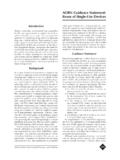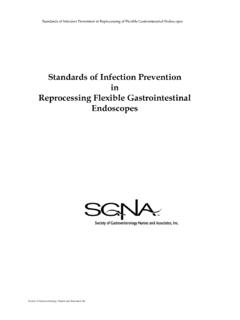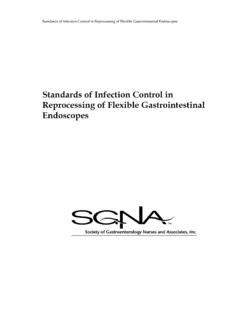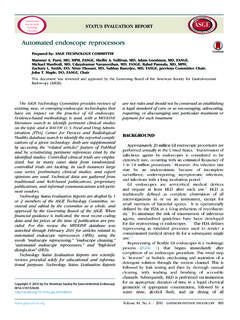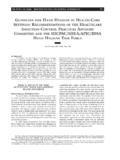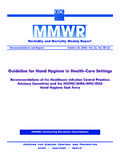Transcription of How-to Guide: Improving Hand Hygiene - ASC …
1 How-to guide : Improving Hand Hygiene A guide for Improving Practices among health care Workers This guide was prepared in collaboration with the Centers for Disease Control and Prevention (CDC), the Association for Professionals in Infection Control and Epidemiology (APIC), and the Society of Healthcare Epidemiology of America (SHEA), and has been endorsed by APIC and SHEA. Valuable input also was provided by the World health Organization's World Alliance for Patient Safety through the Global Patient Safety Challenge. This document is in the public domain and is available on It may be used or reprinted without permission provided appropriate reference is made to the Institute for Healthcare Improvement.
2 4/03/2006. How-to guide : Improving Hand Hygiene A guide for Improving Practices among health care Workers Acknowledgments The Institute for Healthcare Improvement (IHI) acknowledges the valuable contributions of the following individuals: W. Charles Huskins, MD, MSc; Assistant Professor of Pediatrics, Mayo Clinic College of Medicine, Consultant, Pediatric Infectious Diseases, Mayo Clinic, Rochester, MN. John M. Boyce, MD; Chief, Infectious Diseases Section, Hospital of Saint Raphael, New Haven, CT (SHEA). Loretta Litz Fauerbach, MS, CIC; Director, Infection Control, Shands Hospital at the University of Florida, Gainesville, FL (APIC). Barbara I.
3 Braun, PhD; Project Director, Center for health Services Research, Division of Research, JCAHO. Nancy Kupka, DNSc, MPH, RN; Project Director, Division of Standards and Survey Methods, JCAHO. Linda Kusek, Rn, BSN, MPH; Associate Project Director, Division of Research, JCAHO. The purpose of this guide is to help organizations reduce health - care -associated infections, including infections due to antibiotic-resistant organisms, by Improving hand Hygiene practices and use of gloves among health care workers. Institute for Healthcare Improvement, Page 2. How-to guide : Improving Hand Hygiene A guide for Improving Practices among health care Workers The Case for Improving Hand Hygiene and Use of Gloves among health care Workers health - care -associated infections are an important cause of morbidity and mortality among hospitalized patients worldwide.
4 Such infections affect nearly 2 million individuals annually in the United States and are responsible for approximately 80,000. deaths each year. Transmission of health - care -associated pathogens most often occurs via the contaminated hands of health care workers. Accordingly, hand Hygiene ( , handwashing with soap and water or use of a waterless, alcohol-based hand rub) has long been considered one of the most important infection control measures for preventing health - care -associated infections. However, compliance by health care workers with recommended hand Hygiene procedures has remained unacceptable, with compliance rates generally below 50% of hand Hygiene opportunities.
5 Jarvis WR. Selected aspects of the socioeconomic impact of nosocomial infections: Morbidity, mortality, cost, and prevention. Infect Control Hosp Epidemiol. 1996 Aug;17(8):552-557. Pittet D, Mourouga P, Perneger TV. Compliance with handwashing in a teaching hospital. Ann Intern Med. 1999;130:126-130. Lankford MG, Zemblower TR, Trick WE, Hacek DM, Noskin GA, Peterson LR. Influence of role models and hospital design on hand Hygiene of healthcare workers. Emerg Infect Dis. 2003;9:217-23. Many factors have contributed to poor handwashing compliance among health care workers, including a lack of knowledge among personnel about the importance of hand Hygiene in reducing the spread of infection and how hands become contaminated, lack of understanding of correct hand Hygiene technique, understaffing and overcrowding, poor access to handwashing facilities, irritant contact dermatitis associated with frequent exposure to soap and water, and lack of institutional commitment to good hand Hygiene .
6 Pittet D, Boyce JM. Hand Hygiene and patient care : Pursuing the Semmelweis legacy. Lancet Infect Dis. 2001;1:9-20. Institute for Healthcare Improvement, Page 3. How-to guide : Improving Hand Hygiene A guide for Improving Practices among health care Workers To overcome these barriers, the Centers for Disease Control and Prevention's (CDC's). Healthcare Infection Control Practices Advisory Committee (HICPAC) published a comprehensive Guideline for Hand Hygiene in health - care Settings in 2002. One of the principal recommendations of this guideline was that waterless, alcohol-based hand rubs (liquids, gels or foams) are the preferred method for hand Hygiene in most situations due to the superior efficacy of these agents in rapidly reducing bacterial counts on hands and their ease of use.
7 Alcohol preparations also rapidly kill many fungi and viruses that cause health - care -associated infections. The guideline recommended that health care facilities develop multidimensional programs to improve hand Hygiene practices. Boyce JM, Pittet D, et al. Guideline for Hand Hygiene in health - care Settings: Recommendations of the Healthcare Infection Control Practices Advisory Committee and the HICPAC/SHEA/APIC/IDSA Hand Hygiene Task Force. Morbid Mortal Wkly Rep. 2002;51(RR16):1-45. Recognizing a worldwide need to improve hand Hygiene in health care facilities, the World health Organization (WHO) launched its Guidelines on Hand Hygiene in health care (Advanced Draft) in October 2005.
8 These global consensus guidelines reinforce the need for multidimensional strategies as the most effective approach to promote hand Hygiene . Key elements include staff education and motivation, adoption of an alcohol-based hand rub as the primary method for hand Hygiene , use of performance indicators, and strong commitment by all stakeholders, such as front-line staff, managers and health care leaders, to improve hand Hygiene . WHO Guidelines on Hand Hygiene in health care (Advanced Draft): A Summary. World health Organization; 2005. [Available online at ]. Institute for Healthcare Improvement, Page 4. How-to guide : Improving Hand Hygiene A guide for Improving Practices among health care Workers Wearing gloves during patient care is an additional intervention to help reduce transmission of infectious agents in high-risk situations.
9 Gloves protect patients by reducing contamination of the health care worker's hands and subsequent transmission of pathogens to other patients. In addition, when gloves are worn in compliance with CDC's Standard Precautions, gloves protect health care workers from exposure to bloodborne infections such as HIV and hepatitis B and C. However, gloves must be used properly. Gloves can become contaminated during care and must be removed or changed when moving from a contaminated site to a clean site on the same patient. Gloved hands can also become contaminated due to tiny punctures in the glove material or during glove removal; therefore, hand Hygiene must be performed immediately after glove removal.
10 Consequently, use of gloves is an important adjunct to, but not a replacement for, proper hand Hygiene practice. Pittet D, et al. Bacterial contamination of the hands of hospital staff during routine patient care . Arch Intern Med. 1999;159:821-826. Pessoa-Silva CL, Richtmann R, Calil et al. Dynamics of bacterial hand contamination during routine neonatal care . Infect Control and Hosp Epidemiol. 2004;25:192-197. Tenorio AR, Badri SM, Sahgal NB, et al. Effectiveness of gloves in the prevention of hand carriage of vancomycin-resistant Enterococcus species by health care workers after patient care . Clin Infect Dis. 2001;32:826-829. Johnson S, Gerding DN, et al.

